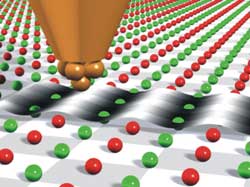| Introduction to STM | Instrumentation | Results / Projects |
| Gallery | Publications | Team |
Scanning Tunneling Spectroscopy

The basic operation principle of a scanning tunneling microscope is described here.
We use the microscope to study the local density of states (LDOS). The LDOS is simply a sum over squared wave functions, where the width of the sum is given by the energy resolution of the experiment. The energy resolution itself is proportional to the temperature of the experiment as long as not influenced by operational conditions of the STM. To increase the energy resolution, we work at T=6 K and T=300 mK, respectively.
According to the Tersoff-Hamann model the LDOS of the sample is directly proportional to the measured differential conductivity dI/dV(V,x,y). Here, x,y are sample positions and eV can be identified with the sample energy with respect to the Fermi level. The model holds rather exactly at low voltages with respect to work functions of the tip and the sample (about 4 eV). Therefore, we basically work at voltages below 200 mV. Moreover the model generally requires s-like tip states. However, dealing with the simple s-like conduction band of InAs, which has a spatially constant decay into vacuum, the result of the Tersoff-Hamann model can be straightforwardly extended to more complicated states of the tip. It should be mentioned that the model is quantitatively correct concerning the (x,y) dependence of the LDOS, but only qualitatively correct concerning the energy dependence.
Thus, we get a quantitative correct measure of the LDOS(x,y) at each energy.
Introduction to STM | Instrumentation | Results / Projects | Gallery | Publications | Team
impressum © copyright 2002 by group R - university of hamburg
